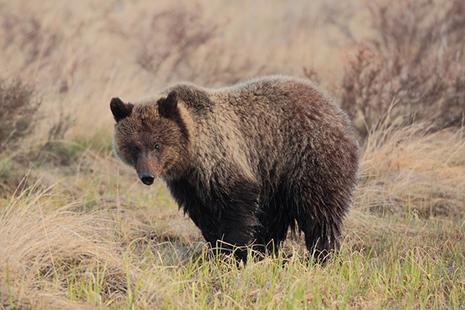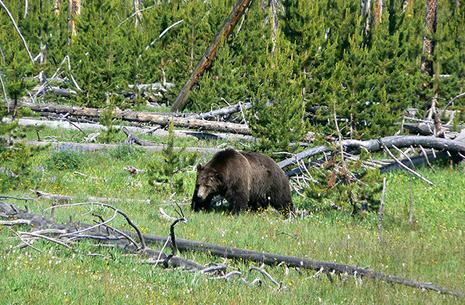Bear Down
It's not time to delist grizzlies.
The U.S. Fish & Wildlife Service is declaring that the Yellowstone population of grizzly bears is recovered and no longer needs the protections of the Endangered Species Act. Certainly we can all agree that the recovery of grizzly bears in the Yellowstone region has been a tremendous success and has prevented this population from going extinct. But have they recovered enough to no longer need federal protections?
The U.S. Fish & Wildlife Service tried removing endangered species protections from this population back in 2007, but a court ordered protections to be restored in large part because the Service had not adequately addressed the effect that the loss of whitebark pine trees might have on the grizzly bears. Whitebark pine is a high-elevation tree whose seeds provide a rich fat and protein source for grizzlies in the Yellowstone region.
Since 2007, the Interagency Grizzly Bear Study Team has conducted a number of studies and essentially concluded that grizzly bears are omnivores and will shift their diets to make up for the loss of the fatty seeds. As such, the agencies claim that the loss of whitebark pine is not a threat to the bears. This conclusion, however, fails to fully account for the costs involved in switching food sources - particularly if the bears switch, as the research indicates they will, to more meat, which will inevitably result in more conflicts with people, which means more dead grizzly bears. In fact, this past year saw the highest number of conflicts between grizzlies and people since the population was first protected in the 1970s.
Additionally, significant questions remain concerning not only the size of the population, but its trajectory. In 2013 a study was published that questioned the accuracy of the methodology used to count the population. Although the federal scientists dispute these findings, they do acknowledge limitations to their counting methodology, which result in a wide range of possible population estimates varying from about 600 to 800 bears. A different methodology with other limitations puts the estimate over 1,000 bears right now.
Most astoundingly though, no one actually knows with any convincing level of certainty how many grizzly bears there are in the Greater Yellowstone Ecosystem today. And while there isn't agreement on the size of the population, there is agreement that the population has not grown since 2003 and is likely to be declining. Despite this, today's proposal to remove federal Endangered Species Act protections would allow the states to begin regulated hunts on grizzly bears outside Yellowstone National Park, virtually guaranteeing that the population will never increase again.
Finally, the Yellowstone population of grizzly bears is isolated from other bear populations and has been for 100 years. Federal scientists recently published a study concluding that the population is genetically doing fine. While this is somewhat reassuring for now, no population of this size can continue in isolation forever without problems. Even the U.S. Fish & Wildlife Service acknowledges this. But rather than requiring that the Yellowstone population of bears establish connectivity with other grizzlies to the north, the Service is content to rely on physically transporting bears (e.g., in trucks) between regions if needed to avoid genetic problems - a proposal that is completely at odds with a "fully recovered" population.
Given all of the uncertainty facing this population, it's not time to declare victory for these bears just yet. Yellowstone grizzly bears are isolated from other populations, they are experiencing high levels of conflicts with people, and the size of the population is likely declining in the wake of the loss of whitebark pine trees, a critically important food source.
The Endangered Species Act has been tremendously successful at saving this population and preventing its demise. And retaining those valuable protections until the Yellowstone grizzly population is more robust and its future more certain is the best way to turn that past success into true recovery.
Sylvia Fallon is a senior scientist with the Natural Resources Defense Council. This blog originally appeared on switchboard.nrdc.org.














